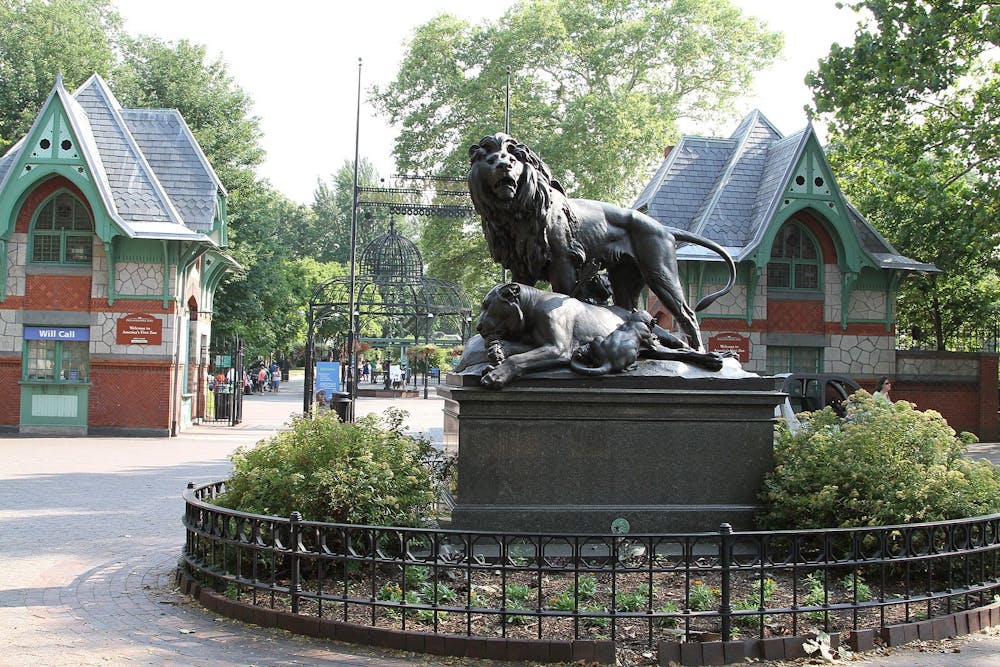
The Philadelphia Zoo house many species who cannot thrive in a zoo setting and are not preparing them for release. (Photo by Jim the Photographer | CC BY 2.0)
My mother, who grew up in Bala Cynwyd, used to visit the Philadelphia Zoo regularly with my grandmother and on school field trips. When I ask my mother about the zoo, she first describes the Victorian structures bookending the zoo’s wrought iron entrance gate and peacocks swaggering freely around the grounds. As a grassroots animal rights activist, however, her nostalgia is quickly eclipsed by melancholy. In a softer tone, she describes an obese walrus idling apathetically in a swimming pool not much larger than its own circumference. Even as a child, she says, she could tell that something was wrong as she looked on at cheetahs and leopards pacing neurotically in barren, concrete enclosures.
According to research in the Journal of Applied Animal Welfare Science, certain animal species including bears, wolves, orangutans, lions, and tigers, cannot thrive in a zoo setting; nevertheless, all the aforementioned animals can be found at the Philadelphia Zoo. And despite the fact that there are tens of thousands of animals threatened with extinction, the Philadelphia Zoo continues to house a number of species of least concern, including pumas, kangaroos, and flamingos, presumably because these animals are more popular among visitors than, say, the endangered Fijian tree snail.
These facts are not particularly offensive nor profound. Yet among even my most progressive acquaintances, pointing out the ethical dubiousness of zoos is often met with reflexive disagreement or a dismissive smile, reactions which seem to reflect the public attitude toward animal rights more broadly — defensive, unbothered, or contradictorily, both.
Zoothusiasts argue that zoos play an important role in wildlife conservation, either by supporting breeding programs or fostering environmentalism among the public. The Philadelphia Zoo’s website has multiple pages dedicated to its conservation efforts. However, the vast majority of zoo animals are not being prepared for release. In fact, it is nearly impossible to release captive-bred animals into the wild successfully, and any efforts to increase the number of endangered animals living in the wild are futile if not matched by commensurate resolve to protect those animal species on the outside — by addressing the root causes of endangerment like habitat destruction, poaching, and the exotic animal trade. Unfortunately, this resolve appears to be lacking in the U.S., where the government has drastically rolled back its environmental agenda over the past decade, including by lifting the ban on sport-hunted elephant trophy imports and weakening the Endangered Species Act.
As instruments for environmental education, zoos miss the mark. One study on the effectiveness of zoos in educating the public found no significant difference in people’s environmental identity, concern, or sense of connection to animals before and after visiting the zoo. Other research has shown that people go to the zoo to enjoy themselves rather than learn, and are receptive to educational initiatives only insofar as it fits within their goals for enjoyment, and because zoos normalize keeping wild animals in captivity, they may actually be counterproductive to conservational pedagogy.
In other words, zoos may be failing to satisfy even the few functions that serve to justify their existence. Why, then, are we so committed to the righteousness of zoos? My suspicion is this: zoos are the crown jewel of a sunny weekend. They are a joyous childhood memory in the individual and collective consciousness, and if zoos are unethical, so too is our visiting them.
That’s why the first step in rectifying the mistreatment of zoo animals is to remedy the flippancy surrounding zoo-animals’ rights and well-being. We must recontextualize zoos in public opinion and ensure that they assume their natural place next to circuses, animal testing, and the other inhumanities that we have begun to accept as such. At the very least, we ought to acknowledge that zoos are both a symptom and cause of a milieu in which too many things — from what we eat, to what we wear, to the places we take our kids on a Sunday afternoon — depend entirely on the institutional exploitation of animals. In a society where recognizing the rights of animals would be so utterly and unimaginably disruptive to our way of life, the reckoning we need is one that we appear to be simply unwilling to have.
If zoos are to exist at all, we must align our idea of them — as ethical, educational, conservation-driven institutions — with our practices, by phasing out the exhibition of all wild animals that cannot flourish in captivity. Conceptually, we must supplant animal welfare with animal well-being, which prioritizes what individual animals want, not how animals can be adequately accommodated within the human-wants-first framework.
So instead of going to the zoo this summer, go play with Nubian goats at the Philly Goat Project, plant a row of native perennials to support declining bee populations, or visit the Holy Spirit Farm and Horse Sanctuary (or another Global Federation of Animal Sanctuaries accredited sanctuary). Donate the $20 zoo-admission fee to an animal rights organization, and most importantly, call, email, and write your local, state, and federal representatives to voice your support for expanding and strengthening legislation that protects animals in their natural environments.
MAISY SYLVAN is a graduate student from Leverett, MA studying social policy. She has a BA from the University of Michigan where she studied environmental policy and creative writing. Her email address is maisyhs@upenn.edu.
The Daily Pennsylvanian is an independent, student-run newspaper. Please consider making a donation to support the coverage that shapes the University. Your generosity ensures a future of strong journalism at Penn.
Donate






